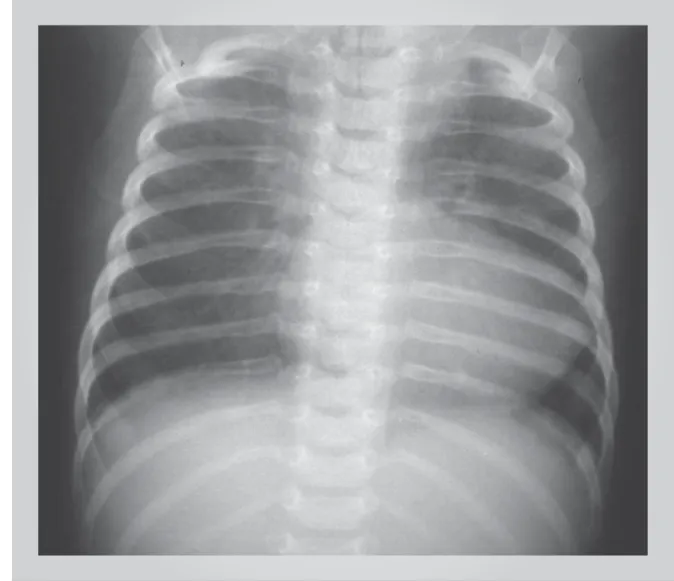Arquivos Brasileiros de Cardiologia - Volume 87, Nº 2, August 2006
Clinicoradiological Session
Clinicoradiological Session
Case 2/2006 – Three-year-old Child with Subaortic
Stenosis, Mitral Stenosis due to Parachute Mitral Valve,
Supravalvular Mitral Stenosis, Coarctation of the Aorta
(Shone Syndrome) Associated with Ventricular Septal
Defect and Ductus Arteriosus
Edmar Atik
Instituto do Coração do Hospital das Clínicas da FMUSP - São Paulo, SP - Brazil
C
LINICAL FINDINGSThree-year-old white male child had undergone surgery at three months of age for correction of a large 10-mm perimembranous ventricular septal defect, small ductus arteriosus, and resection of a mild supravalvular mitral membrane. Improvement of the heart failure was evident and the child weighed 3,545 g at that time, approximately 1,000 g heavier than at birth. He no longer had respiratory distress or liver enlargement at 8 months of age, when he weighed 6,000 g. An intense murmur reappeared as of the 14th month of age on the left sternal border, with mild signs of coarctation of the aorta. At three years of age, he began to present with sporadic episodes of fatigue, accompanied by diaphoresis and gasping that lasted between 15 and 30 minutes. He improved with diuretics and digitalis. Other extracardiac defects such as cleft lip and palate – corrected at the age of 18 months, absence of the right auditory canal, ear malformation, hemivertebra, hydrocele and elongated fi ngers were present. Physical examination revealed no signs of respiratory distress; the patient was acyanotic, active, and with normal pulses in the four extremities. His weight was 9,180 g, height 83 cm, blood pressure in the left upper extremity was 100/70 mmHg, blood pressure in the right lower extremity was 80/50 mmHg and the heart rate was 113 bpm. The aorta was not palpable. Mild impulses were observed in the precordium, on the left sternal border, and the apical impulse was palpable on the 4th left intercostal space, slightly forceful/tapping, limited to one fi ngertip. Heart sounds were accentuated and a grade ++ harsh ejection systolic murmur was observed in the aortic area, suprasternal notch, and left sternal border, accompanied by a fremitus. The liver was palpable 3 cm below the right costal margin.
The electrocardiogram showed classical signs of right bundle branch block, which was present as of the surgical
procedure performed at three months of age. SÂP:+20o, SÂQRS:+150o, SÂT:+40 o. The electrocardiogram prior to surgery showed biventricular overload with predominance of right ventricular overload given the voltage of the S waves, higher than that of the R waves from V4 to V6. V1 showed a 20-mm R wave and SÂQRS was at +150 o.
R
ADIOGRAPH IMAGINGThe image shows a slightly enlarged cardiac silhouette with a rounded left border and upwardly displaced apex, double contour at the right side due to enlargement of the left atrium, slight bulging of the middle arch and clear signs of pulmonary venous congestion with more prominent vasculature in the upper lobes (Figure 1).
D
IAGNOSTICIMPRESSIONThis image suggests the presence of left obstructive heart disease with a mitral valve stenosis-type retrograde pulmonary venous hypertension.
DIFFERENTIAL DIAGNOSIS
All left stenotic lesions have a similar presentation and should therefore be considered. The set of obstructive defects of the Shone syndrome may also have a similar presentation, including hypertrophy resulting from subaortic stenosis and from coarction of the aorta.
D
IAGNOSTICCONFIRMATIONThe clinical fi ndings suggest the diagnosis of subaortic stenosis because of the heart murmur in the aortic area with radiation to the left sternal border, in addition to a mild coarctation of the aorta because of the 20-mmHg
Section Editor: Edmar Atik
Arquivos Brasileiros de Cardiologia - Volume 87, Nº 2, August 2006
gradient between the extremities. No clinical signs of mitral valve obstruction were observed. The pulmonary congestion seen in the chest radiograph helped us understand the rare paroxysmal dyspnea that affected the patient more recently. The echocardiogram showed a 60-mmHg gradient in the left ventricular outfl ow tract due to a subvalvular aortic ridge, a 20-mmHg gradient at the aortic isthmus due to mild stenosis, a parachute mitral valve with valvular opening corresponding to 1.4 cm2, which was considered non obstructive. The left atrium was enlarged. The measurements obtained were: right ventricle 12 mm, diastolic diameter of left ventricle 25 mm, systolic diameter of left ventricle 12 mm, aorta 19 mm, left atrium 30 mm, septum 7mm, posterior wall 6 mm, a 52% shortening fraction, and an 86% ejection fraction. Cardiac catheterization showed more precise diagnostic aspects, emphasizing that the stenosis in the left ventricular outfl ow tract was intense with a 90-mmHg pressure gradient, and that the mitral valve stenosis was critical leading to a 33-mmHg mean
pulmonary capillary pressure with a 15-mmHg gradient in relation to the diastolic pressure of the left ventricle. There was mild coarctation of the aorta with a 10-mmHg gradient at theisthmus. Pressures were 170/18 for the left ventricle, 80/40 for the ascending aorta, 70/40 for the descending aorta, 33 for the pulmonary capillary and 90/40 mmHg for the pulmonary trunk.
MANAGEMENT
Because of the repercussion of the defects, corrective surgery was performed promptly. The parachute mitral valve was opened through an incision in the apex of the left ventricle using papillarotomy and a small comissurotomy. The fi bromuscular ring of the left ventricular outfl ow tract was relieved with an incision in the descending aorta and through the ventricular apex. The coarctation of the aorta was not relieved because of its mild repercussion. The outcome was excellent due to the adequate elimination of the obstructions.
Edmar Atik
THREE-YEAR-OLD CHILD WITH SUBAORTIC STENOSIS, MITRAL STENOSIS DUE TO PARACHUTE MITRAL VALVE, SUPRAVALVULAR MITRAL STENOSIS, COARCTATION OF THE AORTA (SHONE SYNDROME) ASSOCIATED WITH VENTRICULAR SEPTAL DEFECT AND DUCTUS ARTERIOSUS
